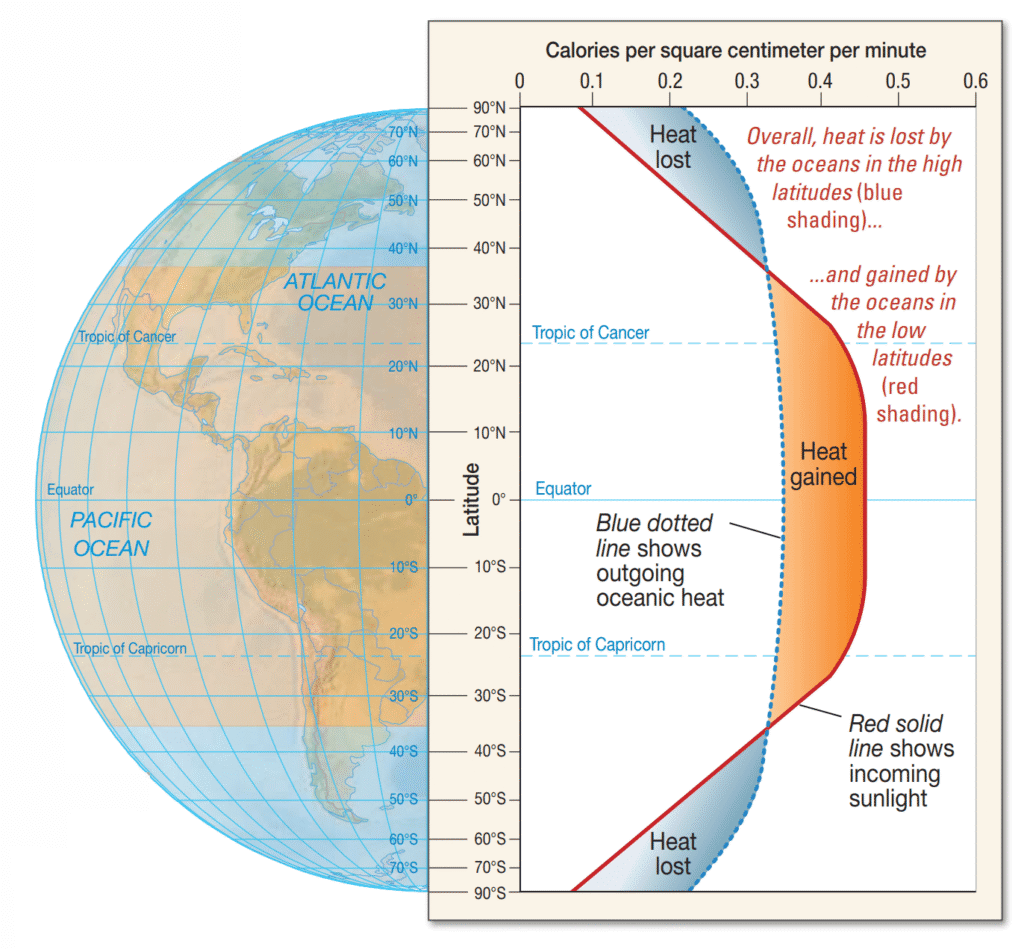What is the ocean heating phenomenon?
Ocean heating phenomenon refers to the systematic redistribution of thermal energy from low-latitude oceanic regions to polar areas through atmospheric and oceanic circulation systems. Near polar regions, solar radiation strikes Earth’s surface at low angles with high albedo from ice surfaces reflecting substantial energy back to space. Conversely, in the 35°N to 40°S latitude zone, steeper solar angles enable greater energy absorption. This creates a net heat gain in equatorial oceans and net heat loss in polar regions, driving global heat redistribution through thermohaline circulation and atmospheric processes.
Oceanic Heat Flow
Near the polar regions, the majority of incoming solar radiation reaches Earth’s surface at relatively low angles, resulting in reduced energy absorption. Moreover, the presence of ice—characterized by a high albedo—leads to a substantial portion of this radiation being reflected back into space rather than being retained. Conversely, in the zone spanning approximately 35 degrees north to 40 degrees south latitude, sunlight approaches Earth at steeper angles, allowing a greater proportion of energy to be absorbed instead of reflected. This region exhibits enhanced solar energy uptake, owing to both the angle of incidence and lower surface reflectivity. A graphical representation demonstrates how daily patterns of incoming solar radiation and outgoing thermal energy result in a net heat gain within low-latitude oceans, while high-latitude oceans experience a net heat loss.
This broader latitudinal range into the Southern Hemisphere is attributed to its larger oceanic surface area in the middle latitudes, compared to that of the Northern Hemisphere.
Based on the depicted energy distribution, one might logically assume that, over time, the equatorial region would become increasingly warmer, while the polar zones would experience a continual cooling trend. Although the polar areas consistently remain substantially colder than the equatorial belt, the temperature gradient between them persists without significant alteration. This stable differential occurs because the surplus thermal energy accumulated in the equatorial zone is systematically redistributed toward the poles.

What facilitates this essential heat transfer?
It is primarily achieved through the circulatory systems of both the oceans and the atmosphere, which function collectively to relocate this excess heat, thereby maintaining a relatively balanced global temperature distribution.
The Albedo Effect in Ocean Heating
The albedo effect plays a crucial role in ocean heating phenomenon. Polar ice surfaces exhibit albedo values of 0.7-0.9, meaning they reflect 70-90% of incoming solar radiation back to space. This creates a powerful cooling effect that helps maintain polar regions’ low temperatures. In contrast, open ocean surfaces have albedo values around 0.06, absorbing approximately 94% of solar energy.
When polar ice melts due to warming, it exposes darker ocean surfaces that absorb more solar radiation, creating a positive feedback loop known as ice-albedo feedback. This mechanism accelerates ocean warming in polar regions and contributes to global heat redistribution patterns.
Thermohaline Circulation: The Global Heat Engine
The thermohaline circulation system, often called Earth’s “global conveyor belt,” is driven by density differences created by temperature (thermo) and salinity (haline) variations. This circulation system transports approximately 1.5 petawatts of thermal energy globally, playing a critical role in climate regulation
In the North Atlantic, surface water cools and becomes saltier through evaporation, increasing its density until it sinks to form North Atlantic Deep Water (NADW). This water mass flows southward at depth, eventually joining the Antarctic Circumpolar Current. The complete circulation cycle takes approximately 1,000 years, continuously redistributing heat from equatorial regions to polar areas.

FAQS
What causes ocean heating phenomenon?
Ocean heating phenomenon is caused by uneven solar radiation distribution across Earth’s surface. Equatorial regions receive more direct sunlight and absorb greater energy due to steeper solar angles, while polar regions receive less energy due to shallow angles and high albedo from ice surfaces reflecting sunlight back to space.
How does albedo affect ocean temperatures?
Albedo significantly impacts ocean temperatures by determining how much solar radiation is reflected versus absorbed. Ice-covered polar regions have high albedo (0.7-0.9), reflecting 70-90% of sunlight, while open ocean has low albedo (0.06), absorbing most incoming solar energy and contributing to oceanic warming.
What is thermohaline circulation in ocean heating?
Thermohaline circulation is the global oceanic circulation system driven by temperature and salinity differences that redistributes heat from equatorial to polar regions. Cold, salty water sinks at poles while warm surface water flows poleward, creating the ‘global conveyor belt’ that transports excess equatorial heat worldwide.
Why don’t equatorial oceans become infinitely hot?
Equatorial oceans maintain stable temperatures because surplus thermal energy is systematically redistributed toward polar regions through oceanic and atmospheric circulation systems, preventing continuous warming and maintaining relatively balanced global temperature distribution.
Reference: All images and content are taken from Essentials of Oceanography by Alan P. Trujillo and Harold V. Thurman, 12th Edition.
